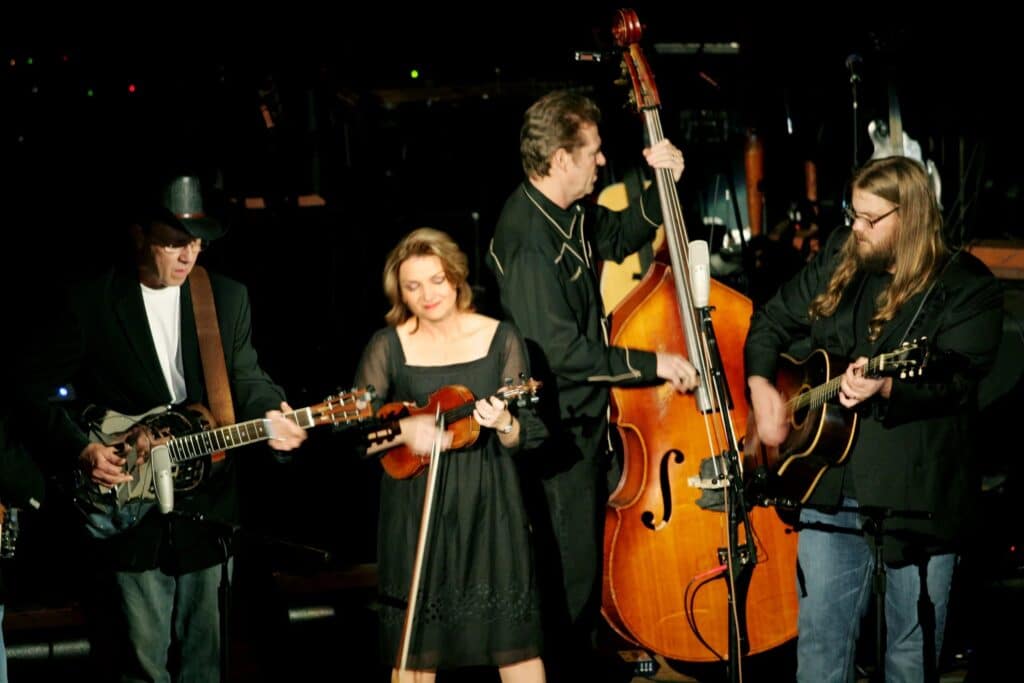The Meaning of The Steeldrivers’ “Where Rainbows Never Die”

Before rising to fame as a solo artist, Chris Stapleton had his hands in a number of projects, including a stint as the lead singer for bluegrass band The Steeldrivers from 2008-2010. During his time with The Steeldrivers, Stapleton collaborated with the group’s mandolin player, Mike Henderson, to write some of their most well-known songs, including the cosmic country gem, “Where Rainbows Never Die.”
“Where Rainbows Never Die” is a song about an old man who’s taking stock of his life, off the second Steeldrivers album, Reckless (2010). The lyrics describe this gentleman’s anticipation of a peaceful afterlife, where he can cast aside the stresses of life on earth and watch the sunsets fade away until the end of time.
“Where Rainbows Never Die” Lyrics Meaning
In the first verse, Stapleton brings us into the mind of this old timer as he looks back on his younger days, recognizing that time has gotten the best of him:
I’m an old man now, I can’t do nothing
First verse to “Where Rainbows Never Die” by The Steeldrivers.
Young folks don’t pay me no mind
But in my day I sure was something
Before I felt the heavy hand of time
This old man is not quite what he used to be, and notices that younger people don’t even seem to pay attention to him. He recalls that he was once a younger man, and perhaps accomplished many things in his life, but now time has placed a heavy weight upon his shoulders.

In the second verse, Stapleton repeats the old man line from the first verse, but this time he sings of the old man preparing to meet his end:
I’m an old man now, I’m bound for glory
Second verse to “Where Rainbows Never Die” by The Steeldrivers.
Time to lay these burdens down
Had enough of this old world
Of worry
Gonna trade my troubles for a crown
When he sings of being “bound for glory,” he means that he is heading towards heaven, where he will have a chance to lay down the burdens that he has amassed over the course of his life. He describes being ready to die, as he’s “had enough of this old world of worry.”
The whole song gives off a biblical energy, with the idea of going to heaven after death being the central focus. When Stapleton sings of trading his troubles for a crown, he is referencing the five heavenly crowns discussed in the bible, which are said to be awarded to followers of Christ upon their arrival in heaven.
In the chorus, the lyrics depict the moment that the old man crosses over into heaven, and how he hopes that things might turn out:
I will make my way across the fields of cotton
Chorus to “Where Rainbows Never Die” by The Steeldrivers.
And wade through muddy waters one last time
And in my dreams I come out clean
When I reach the other side
West of where the sun sets
Where rainbows never die
Here we imagine a journey through hard environments like cotton fields, representing work, and muddy waters, representing uncertainty and difficulty. This is symbolic of one’s journey trough life.
The old man in “Where Rainbows Never Die” has dreamed of passing through the muddy waters and coming out clean and dry on the other side, meaning that he leaves behind the dirt and grime of life for a new beginning in the afterlife.
In heaven, or the “other side,” the old man plans to watch sunsets for eternity, in a place where the rainbows never fade away.

However, before the old man truly passes on, he has one final duty here on earth:
I’ve got one last thing to do
Bridge to “Where Rainbows Never Die” by The Steeldrivers.
One more mile before I’m through
Casting off these earthly chains
Going where there’s no more pain
The old man has to finish tying up all his loose ends on earth before passing away. He’s in the final mile of his long life, which means that he’s quite close to the end and he feels that he’s ready to move on.
From there, Stapleton repeats the chorus, and our old man fades away into the clouds.
“Where Rainbows Never Die” is a thoughtful song that offers of an early example of Chris Stapleton’s incredible skill as both a songwriter and vocalist. He had honed his chops long before emerging as a successful solo artist, even before joining The Steeldrivers, writing songs for artists like Kenny Chesney, George Strait, and Luke Bryan.
However, it was during his time with The Steeldrivers when the world first got a taste of the sound that Stapleton would later perfect under his own name. Songs like “Where Rainbows Never Die” are glimmering examples of Stapleton’s songwriting prowess, even in the early stages of his career.
Listen below.